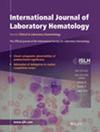Frozen/Thawed Samples Can Replace Fresh Samples for Assignment of ISI to Secondary Thromboplastin Standards for Multiple Reagent/Instrument Combinations: Data to Support Possible Revision of WHO Guidelines
Abstract
Background
Calibration of thromboplastins is required for accurate calculation of the international normalised ratio (INR). Accurate INR results are required for optimal dosing of vitamin K antagonists. Decreases in vitamin K antagonist usage have made the recruitment of sample sets for international sensitivity index (ISI) calibrations more difficult. A possible solution to this would be to allow the use of frozen–thawed samples in place of fresh plasmas in the calibration of secondary standards.
Objectives
We investigated the effect of freezing and thawing samples before usage in ISI calibrations of secondary standards.
Methods
Multiple reagent/instruments were tested to identify the degree of difference between a fresh sample ISI calibration and one performed on frozen–thawed samples. Where possible, the two ISI calibrations were performed on the same sample set. Alternatively, a separate set of samples from different patients was used.
Results
The difference in ISI values was <3% for those datasets where the same samples were used, and <6% for those datasets where two sample sets were used. Additionally, other parameters required for a valid ISI calibration showed only minor differences—some calibrations showed fewer outliers in the frozen–thawed datasets. Mean normal prothrombin time for the international reference thromboplastins was <3.5% different across four different calibrations (two for rabbit thromboplastin and two for recombinant human thromboplastin).
Conclusions
This modification to the WHO guidelines would facilitate the recruitment of test plasmas in advance of calibration solving the problem of requiring availability of fresh patient samples with a range of INRs in a 5-h window.
Trial Registration: Not a part of any clinical trial.

 求助内容:
求助内容: 应助结果提醒方式:
应助结果提醒方式:


